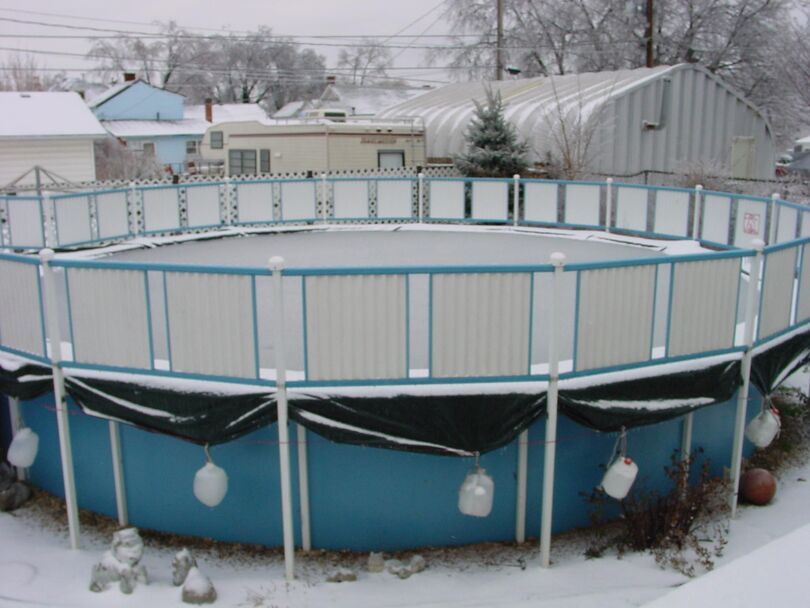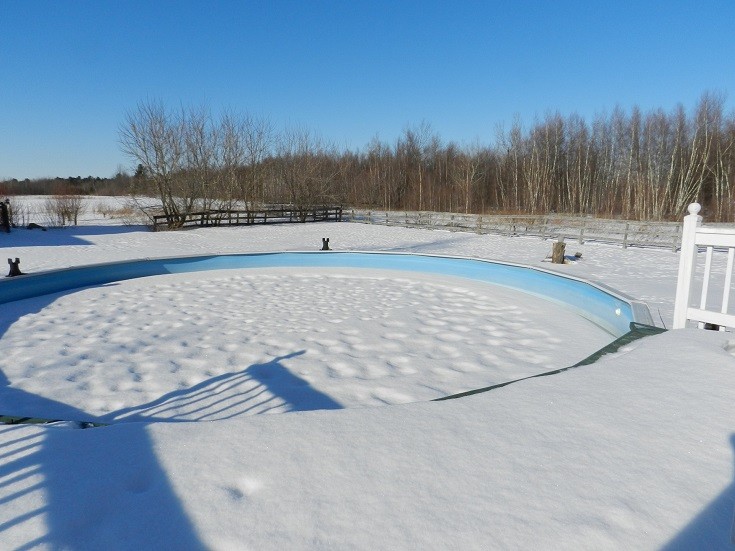How To Winterize Your Above-Ground Pool
-
- Last updated:


The seasons will turn, from summer into fall and from fall into winter. When that happens you need to winterize your above-ground pool to protect it from the cold, snow, and ice of the hibernal months.
Winterizing your pool can be a trifle time-consuming and cost a little bit, but failure to take these steps can lead to cracked hoses, busted filters, and broken pumps. This is a definite case of “penny wise and pound foolish.” So if you want to avoid that dreaded syndrome, we can definitely help. Follow the steps below, in order, and you’ll successfully prepare your pool to survive the winter.

Water
During the winter, the pump won’t be circulating the water in the pool, so it’ll be sitting stagnant during those months. Before shutting down your pool, make sure the water is clear, clean, and chemically balanced to reduce algae growth as much as possible. You’ll need to set the chemical levels as follows:
- pH: 7.2 – 7.6
- Alkalinity: 80 – 120 ppm (parts per million)
- Calcium Hardness: 175 – 200 ppm
- Chlorine: 1 – 3 ppm
Check the water, testing it and adjusting just like you normally would until you reach these levels.

Equipment
Remove all the deck and poolside equipment such as stairs, ladders, floats, etc. Dry them off and store them in a cool, dark area. If you don’t have a storage area, cover them with a waterproof tarp, tied down tight. Don’t try to make it airtight or watertight though. That could lead to condensation problems, algae growth, and freeze damage.
Cleaning
Brush down all the sides and bottom of your pool. Scrub it hard to remove any microscopic particles or algae that might be holding on. Vacuum the pool once everything has settled. This will prevent staining, which can happen if any dirt or debris is left in the pool for months at a time.
Clean out the skimmer, filter, and pump basket. Remove all unused chlorine tabs. Wash the removable parts with soap and water.
Backwash your sand or diatomaceous earth filter to remove any debris it might have caught. Don’t add any water to the pool after backwashing – you’re going to be draining some of the water out of it anyway so there’s no point in adding any.
If you have a cartridge filter, remove the cartridges and wash them. Store them with your other pool equipment.
- High Quality Nylon Brush - Our bristle brush features an alumium bracket & reinforced backing for long-lasting durability. It includes...
- E-Z Clip Connection - Our wall cleaning brush quickly attaches to most standard 1 1/4 inch poles. Just push the scrub brush and snap it...
- 20" Extra Wide Sweep Area - The Greenco pool scrubber finishe the job faster due its large size. The 45 degree head bracket makes...
Winterizing Chemicals
A good winterizing kit can be found at most pool supply stores. It should contain shock and a winterizing algaecide. Add the shock and let it sit for several hours or overnight, then put in the algaecide. If there are additional chemicals, follow the instructions on the kit for adding them. Your pump should be off by this point so be sure to scatter the chemicals around so they’re evenly dispersed.
Water Level
Drain the water level in your pool until it’s about 2-inches below your return jet, which in turn is usually below the level of your skimmer. If you don’t have a valve for draining the pool (some pools do), you’ll need to get a siphon pump to drain water out of the pool. Be sure to direct the water away from your house, patio, garage, shop, etc.

Winterize the Skimmer, Pump, and Hoses
Gut your skimmer, removing all the internal parts and put a rubber plug in the return line (the line that goes to the pump and filter). Unscrew the eyeball out of the return jet and replace it with a rubber plug as well. Disconnect all the hoses, dry them out, and store them along with the skimmer and return jet parts with the rest of your pool equipment.
Remove all the drain plugs from the pump and filter (see your instruction manual for directions) to drain the water from them and let them breathe during the winter. Cover them with a tarp but don’t try to make it watertight or airtight. As we said, they need to breathe during the winter. This will avoid algae build-up or freeze damage.
Air Pillow
An air pillow is a large balloon type of device, usually six to eight feet long that fills with air and sits on top of the water in your pool. Inflate an air pillow and anchor it in the center of the pool. They usually have long tie straps attached for this purpose. If the water in the pool freezes during the winter, it will expand inwards toward the air pillow, compressing it, inside of expanding outward and possibly damaging the sides of the pool. An air pillow is cheaper than replacing the pool, so don’t skimp on this step.
Pool Cover
Place a winter cover over your pool with the black side down. If you don’t have a deck all the way around the pool, thread the cable through the grommets or loops then tighten the cover to hold it securely in place. If you do have a deck around the pool, place water bags 3/4 full of water on the edges of the pool cover to weigh it down.
Don’t fill the water bags or they’ll burst when it freezes. Don’t use concrete blocks, bricks, or pieces of wood to weight down the cover either. They’ll damage it and/or the pool.
- Winter pool cover to be used with in-ground swimming pools
- Solid material will not let water pass through
- Pool Size: 25 x 45 Foot Rectangle - Cover Size: 30 x 50 Feet (includes overlap in total)

Cover Pump
Now that your pool is ready for the winter, the last step is to keep an eye on the water that accumulates on the cover (it always happens). The best way to remove it is with a cover pump, a small electrical pump designed to suction water off the cover and get rid of it through a length of hose. Water is heavy – 8.25 pounds per gallon. If too much water accumulates on the cover it can put stress on the grommets, the sides of the pool, or the weights holding it in place. Cover pumps are inexpensive. Get one and use it.
- Pool Cover Maintenance - The WAYNE 1/4 HP Reinforced Thermoplastic Pool Cover Pump is a great addition to your pool maintenance. WAYNE...
- Automatic Pumping - Water level must be at least 2-1/8” for the pump to turn on, prime, and operate. Water levels less than 2-1/8”...
- Efficient Design - Energy efficient, high flow, oil-free pump. Easy on/off allows you to plug in and leave the pump unattended for...
Now you’re ready for the winter!
- Related Read: 10 Best Cheap Water Filters: Reviews & Top Picks
Featured Image Credit: Jonathan Hogue, Pixnio
Contents




